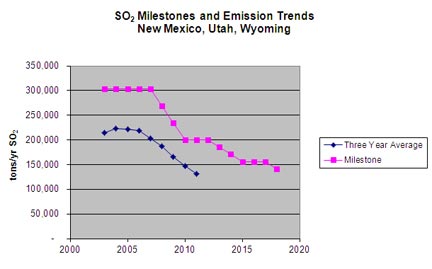By Colleen Delaney
Utah has some of the most spectacular scenery in the West, particularly in our state’s five national parks. But hazy skies can spoil the experience, and the pollution that creates this haze can also harm human health. Thanks to over 20 years of collaborative work with regional stakeholders, Utah has significantly reduced the emissions that contribute to the formation of regional haze.
We were able to reach our emission-reduction milestones seven years ahead of schedule through our Regional Haze State Implementation Plan (SIP), and we are proud of that accomplishment. But more work remains to be done, particularly for natural sources of pollution over which we have less control, such as wildfire smoke and windblown dust.
Regional Haze
Haze is made up of small particles like dust, smoke, and droplets (wet aerosols) that absorb and scatter light, reducing the clarity and color of what you see. Regional haze is produced by air pollutants that come from a variety of sources from a large geographical area. This haze can travel long distances, reducing visibility in places that are often far from the source of the pollution.
The pollutants that create regional haze include sulfur dioxide (SO2), nitrogen oxides (NOx), and particulates. Some pollutants are emitted directly, while others are the product of chemical reactions in the air. Sources include on- and off-road vehicles, industrial facilities such as coal-fired power plants, wildfires, and windblown dust.
In the West, regional haze can significantly impair views in natural areas. In 1977, Congress amended the Clean Air Act (CAA) to include provisions that protect visibility in national parks and wilderness areas. Since then, Utah and other western states have been working together to address the causes of regional haze and find ways to reduce the emissions that contribute to it.
Regional Haze State Implementation Plan (SIP)
In 1999, the EPA developed a regional haze rule to protect and improve visibility in Class I areas on the haziest days (the worst 20 percent) and ensure there was no degradation on the clearest days (the best 20 percent). States across the country are required to collaborate on plans and regional strategies to reduce the emissions that contribute to the formation of regional haze in their state as well as neighboring states.
Utah adopted its Regional Haze State Implementation Plan (SIP) in 2003, five years earlier than most states in the country. The plan was based on the recommendations of the Grand Canyon Visibility Transport Commission (GCVTC). The GCVTC evaluated haze at Class I Areas on the Colorado Plateau, including Utah, and determined that stationary source reductions should center on sulfur dioxide (SO2) because it had the most significant impact on haze.
The 2003 SIP, along with a subsequent revision in 2008, required, among other things, for four PacifiCorp coal-fired power plant units to install emission controls using Best Available Retrofit Technology (BART). Controls were installed beginning in 2006, and were completed on the final unit in 2014. These controls resulted in significant reductions of SO2, NOx, particulate matter, and mercury. These emission reductions were achieved early and have been improving visibility for almost 10 years in Utah’s national parks. In April, 2015 PacifiCorp shut down the Carbon coal-fired power plant, leading to even greater emission reductions.

Since 2002, SO2 emissions from these three power plants have been reduced by 27,947 tons per year, and emissions of NOx have been reduced by 15,258 tons per year.
On December 14, 2012, EPA approved the majority of Utah’s Regional Haze SIP, but disapproved Utah’s BART determinations for NOx and particulate matter (PM) for the four PacifiCorp units. EPA’s disapproval did not address the emission controls but rather determined that a more thorough analysis was required.
DAQ has now updated the analyses as required by EPA. The new analysis includes the visibility benefit due to the shutdown of PacifiCorp’s Carbon Power Plant and determines that the overall emission reductions will achieve greater visibility improvement than could be achieved by installing the most stringent technology available to reduce NOx emissions, selective catalytic reduction (SCR), on the four other units. SCR is an effective, but very expensive, technology, so the SIP achieves better results at a much lower cost. The Air Quality Board will review this analysis and the public comments received on the proposal and will finalize revisions to the Regional Haze SIP in June 2015.
Progress
Emissions reductions, particularly for SO2, have enhanced visibility in the state. Utah has seen an overall improvement in visibility in all of its Class I areas for both the 20 percent best days and the 20 percent worst days between 2000 and 2013.
Utah and its surrounding states have made great strides in reducing regional haze, but much work remains to be done. Like many air pollution problems, regional haze is complicated by a number of factors that don’t always respond well to regulatory controls. Windblown dust and wildfires due to increasing drought conditions will complicate efforts to reduce regional haze. While reductions in SO2 and NOx emissions have helped improve visibility throughout most of the year, wintertime values have not improved as expected This may be due to low levels of ammonia that react with NOx to form ammonium nitrate. If there is not enough ammonia to drive the chemical reaction, then further reductions of NOx will not lead to a corresponding reduction in ammonium nitrate.
Still, Utah has much to celebrate. Visibility has improved at our national parks. Control strategies at coal-fired power plants and new federal standards for vehicle emissions have improved our overall air quality while reducing regional haze. There are no easy answers, but DAQ will continue to search for solutions, not only to regional haze but also to air quality issues statewide.
Please visit our Regional Haze webpage to learn more about Utah’s efforts to reduce regional haze. The Western Regional Air Partnership (WRAP) provides technical analyses and databases to assist states with implementation of the Regional Haze Rule and offers reports and updates on its website. EPA’s Regional Haze Program site provides basic information, SIP milestones, visibility reports and trends in parks and wilderness areas, and regulatory actions for regional haze.

I have worked for DAQ as an environmental scientist for 26 years, primarily working on ozone and regional haze. I have a BA in English from the University of Notre Dame and a BS in Biology from the University of Utah. My five kids, ages 6 to 15, keep me busy! We all like to hike and backpack, especially in Southern Utah.
